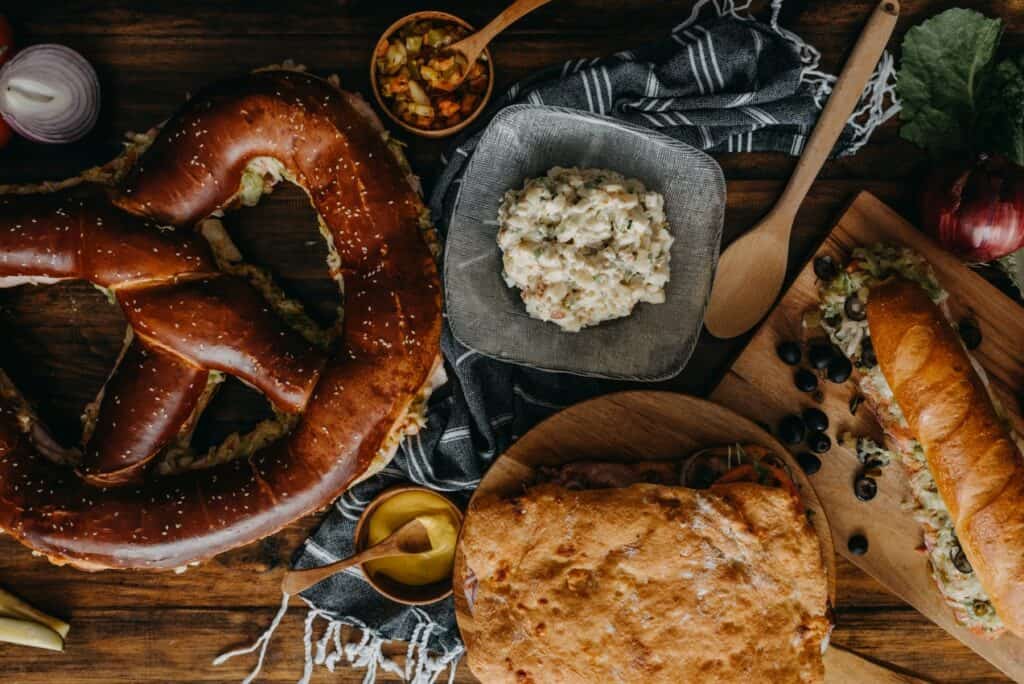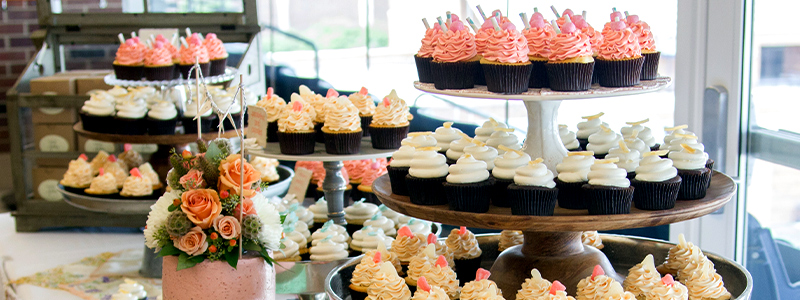Phenomenal Catering Maddington Solutions for Your Next Occasion
Phenomenal Catering Maddington Solutions for Your Next Occasion
Blog Article
Understanding the Art of Bakeshop Products: From Newly Baked Breads to Tempting Pastries and Finger Foods
From the science behind the best loaf of bread, where fermentation and gluten development play essential duties, to the finesse needed for creating split pastries, each element reveals an engaging narrative of workmanship. The convenience of finger foods illustrates exactly how taste and structure can be artfully combined to involve varied preference choices.
The Science of Bread Making
At the heart of every loaf of bread exists a remarkable interaction of chemistry and biology. The process of bread making begins with the combination of flour, salt, yeast, and water-- each component playing a vital role in the final product.
Yeast, a living microorganism, ferments the sugars existing in the flour, generating carbon dioxide and alcohol in the procedure. The co2 gas develops bubbles in the dough, causing it to increase and develop a light appearance. The temperature level and humidity throughout fermentation dramatically affect yeast activity and, subsequently, the bread's flavor and structure.

Learning Pastry Strategies
Just how can one attain the fragile balance of appearance and taste that specifies exceptional bread? Mastering bread methods requires a deep understanding of ingredients, techniques, and the science behind them. Basic to this craft is the option of high-quality active ingredients-- flour, butter, sugar, and eggs-- each playing an essential role in the end product's taste and structure.
The strategy of lamination, which involves folding layers of dough and butter, creates the preferred flakiness in pastries like croissants and puff pastry. Precision in temperature level is important, as butter must stay chilly to make certain optimal layers. In a similar way, appropriate blending approaches, such as the creaming technique for cakes, make sure even unification of air and fat, resulting in a light and ventilated crumb.
Additionally, preserving the best moisture levels during baking can considerably influence the result, ensuring that pastries increase appropriately and attain that golden-brown surface. The art of bread also requires perseverance and technique; each effort enhances one's skill and understanding of the elaborate balance required to develop alluring breads that delight the detects. Proficiency in these techniques inevitably identifies a skilled bread cook from an amateur.
Sorts Of Finger Foods
The globe of cooking thrills prolongs beyond pastries to include a large range of finger foods, which are celebrated for their benefit and convenience. These bite-sized treats are excellent for social celebrations, using an array of tastes and structures that deal with varied tastes.

On the sweeter side, small tarts and bite-sized cupcakes offer a fascinating finish to any kind of meal, interesting those with a pleasant tooth. Cheese and charcuterie boards offer as an advanced choice, allowing visitors to customize their attacks with an assortment of meats, fruits, nuts, and cheeses.
Taste Profiles in Cooking
Baking is a detailed dancing of flavor accounts that incorporates wonderful, full-flavored, and umami notes to develop an unified experience for the palate. Comprehending these profiles is vital for bakers seeking to raise their developments.
Sweet taste typically functions as the foundation in baked items, with sugars, fruits, and all-natural sweeteners enhancing taste deepness. Ingredients such as chocolate and sugar present intricate wonderful notes that can either dominate or complement various other tastes. On the other hand, tasty elements, often located in pastries and breads, offer equilibrium and contrast. Components like cheeses, seasonings, and natural herbs can transform a simple dough right into a diverse flavor experience.
Umami, often forgotten in baking, plays a substantial role in improving flavors. Components such as aged cheeses, fermented items, and even specific nuts contribute to a mouthwatering deepness that improves total taste.
Furthermore, the interaction of acidity from components like buttermilk or citrus enthusiasm can brighten flavors, view using a revitalizing counterpoint to sweetness. By thoughtfully incorporating these taste accounts, bakers can craft items that resonate with diverse tastes buds, producing a remarkable cooking experience. Ultimately, understanding flavor profiles is crucial to development worldwide of cooking.
Essential Cooking Devices and Ingredients
Understanding flavor profiles in cooking collections the phase for picking the right tools and ingredients that help with the development of phenomenal baked goods. The structure of effective cooking depend on having crucial devices available. Key items include mixing try this web-site bowls, measuring mugs, and spoons for precision, in addition to a durable stand mixer or hand mixer for uncomplicated mixing. A trusted collection of cooking frying pans-- such as sheet pans, loaf pans, and cake pans-- is crucial for achieving desired shapes and appearances.
Flour serves as the foundation of many dishes; choosing the right type-- be it all-purpose, bread, or bread flour-- can considerably affect the end result. Baking powder and baking soft drink are vital for developing lift in breads and cakes.
Additionally, integrating taste enhancers like vanilla remove, spices, and citrus passion can elevate your productions. By guaranteeing accessibility to these basic tools and components, bakers can with confidence start their cooking trip, crafting a diverse range of fascinating baked items.
Final Thought
Finally, the art of bakery products includes an extensive understanding of both innovative strategies and clinical concepts. Mastery in bread making, pastry preparation, and finger food discussion exposes the detailed relationships between processes and components. Exploring diverse flavor accounts enhances the baking see experience, while crucial devices and ingredients give the structure for success. Ultimately, the enchanting globe of cooking grows on the unified interaction of science and imagination, resulting in a myriad of delightful culinary developments.
How can one attain the delicate equilibrium of structure and flavor that specifies phenomenal bread? Fundamental to this craft is the option of high-quality active ingredients-- flour, butter, sugar, and eggs-- each playing a vital function in the last item's flavor and appearance.

Recognizing taste profiles in baking sets the stage for selecting the right tools and ingredients that help with the development of outstanding baked items. Discovering varied taste accounts improves the baking experience, while crucial devices and active ingredients give the structure for success.
Report this page